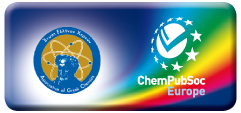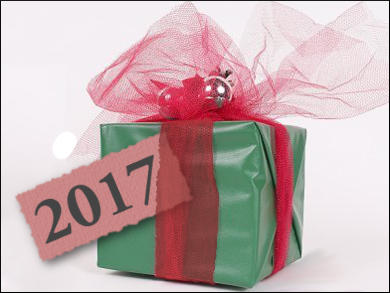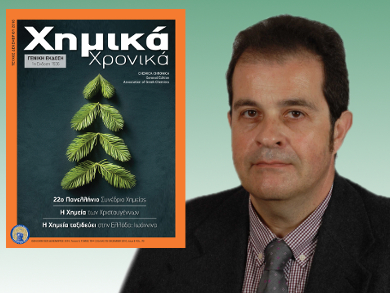Our ChemPubSoc Europe Advent Calendar highlights articles from magazines of the ChemPubSoc Europe societies. Chemica Chronica (Χημικά Χρονικά) is the membership magazine of the Association of Greek Chemists (Ένωση Ελλήνων Χημικών, ΕΕΧ). Dr. Symeon Kyriakidis (pictured) is the Chair of the Editorial Board of Chemica Chronica.
Symeon Kyriakidis chose Η Χημεία… των Χριστουγέννων! (The chemistry of … Christmas!) by Eleni Tella.
Why have you selected this article?
I have selected this article for its originality and seasonality. It deals with colors and with the chemistry of everyday life. Furthermore, its chemistry is involved with all five senses: taste (Christmas turkey and candy canes), sight (poinsettia plants and LED lamps), touch (artificial snow), smell (Christmas tree), and sound (Christmas bells and party poppers).
What is the article about?
Chemistry is present during Christmas time, “the most wonderful time of the year”: The aroma of natural Christmas trees is due to α- and β-pinene and bornyl acetate. Thousands of LED lamps give season atmosphere and gallium compounds are responsible for this. Christmas bells are made from high-tin bronze alloys, while silver nitrate, ammonia, and glucose are used for silver-coated Christmas ball ornaments. Gingerone (4-(4-Hydroxy-3-methoxyphenyl)butan-2-one) and menthol (2-isopropyl-5-methylcyclohexanol) give the flavor and taste to gingerbread cookies and candy canes, respectively.
The Maillard reaction between amino acids and reducing sugars gives the Christmas turkey its distinctive flavor and taste. When champagne bubbles burst at the surface, they deliver flavor and aroma due to various compounds (γ-decalactone, methyl dihydrojasmonate, decanoic acid, dodecanoic acid, palmitic acid, palmitoleic acid, ethyl myristate, etc).
The party popper’s content is a sensitive explosive called Armstong’s mixture (red phosphorus and potassium chlorate). Artificial snow is one of the commercial uses of sodium polyacrylate, a superabsorbent polymer which has the ability to absorb 200–300 times its own mass in water.
Can you say a few words about yourself, please?
I studied chemistry at the Aristotle University of Thessaloniki, School of Chemistry, Greece, and obtained my Ph.D. in biochemistry from the same university. I have worked as a research scientist at the National Hellenic Research Foundation, Greece, and at the Institut National de la Recherche Agronomique (INRA), France.
Since 2000, I have worked at the General Chemical State Laboratory in Athens, Greece, and I am involved with GMOs and allergen detection in foodstuffs. I have been a member of the Association of Greek Chemists since 1983. From the beginning of 2016 until today, I have been the Chair of the Editorial Board of Chemica Chronica.
Thank you for sharing this article with us.
- Link to the article:
 |
|
- Browse an issue of Chemica Chronica
- Go back to the ChemPubSoc Europe Advent Calendar
Also of Interest

Editors recommend science-themed holiday gift ideas

When we light a candle, the chemistry we are pursuing is not only especially beautiful, but also especially complex

A compilation of articles on chemistry related to light

173 million deliveries in 31 hours? We look at the science behind Santa’s Technosleigh and what makes Rudolph’s nose glow




